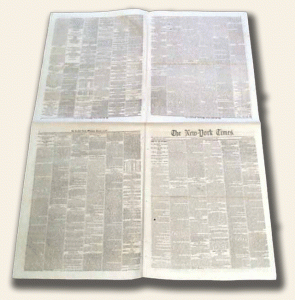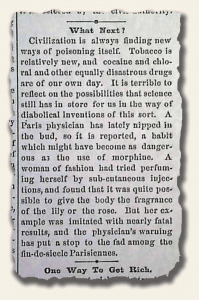Uncut newspapers: leave as they are?
March 20, 2010 by TimHughes · 1 Comment
 Fellow collector Morris Brill poses an interesting question worth sharing with others, along with my thoughts on the issue.
Fellow collector Morris Brill poses an interesting question worth sharing with others, along with my thoughts on the issue.
I suspect we have all encountered “uncut” newspapers from the 19th century, issues which are eight pages in length but which are essentially one large sheet of paper printed on both sides, then folded twice to produce the eight pages. This is how they came off the printing presses . Morris inquires:
“For the sake of maintaining the monetary value of such a newspaper is it best to leave the paper in this one piece condition or is it best to cut the paper so it folds normally like a book and the pages can be turned individually?”
Uncut issues are, for the most part, those which have survived the years by not being bound, kept loose by previous owners and eventually finding their way into the hands of collectors. Given that the vast majority of early newspapers in the collector market came from bound volumes once stored by libraries or other institutions then “disbound” into individual issues, uncut newspapers are relatively few in number. Once bound all margins, save for the spine, are guillotined at the bindery to produce an even, book-like edge thus losing the attachment at the top.
Since uncut issues are newspapers in the original state, as they were sold on the streets, my preference would be to keep them as such. Most collectibles tend to be more desirable in their original state: never clean an old coin; never paint an antique wagon; don’t removed the aged patina from an antique desk, etc. Are such newspapers more clumsy to read? Yes, to some degree. But they can be folded back and all 8 pages read with little difficulty. It’s obviously how it was done years ago as I’ve purchased several boxes of uncut 19th century newspapers which were folded many different ways, left as such by the reader.
They only time I might suggest cutting the top of an uncut sheet is the rare occasion when an issue was bound, causing all four leaves to be attached at the spine, yet the tops have not been trimmed. In such situations the newspaper cannot be folded back because of the attachment at the spine. I would take an exacto knife and cut the very top along the fold. Not much else can be done if the interior pages are to be read.
Collectors may have noticed that we charge a small premium for uncut newspapers. A downside to an uncut issue is they tend to be more worn than those bound as they have not been protected through the years by the bindings, but if one can obtain an issue which is both uncut and in great condition–and contains the Gettysburg Address–there’s a great item for any collection!
Featured websites – TeachHistory.com
March 18, 2010 by GuyHeilenman · Leave a Comment
 Teachers with a love of history, listen up! The following resource can improve your curriculum and make you a stronger educator. Students of history will enjoy the breadth and depth of the historical journey as well.
Teachers with a love of history, listen up! The following resource can improve your curriculum and make you a stronger educator. Students of history will enjoy the breadth and depth of the historical journey as well.
TeachHistory is a fantastic website (blog), developed and maintained by Ben Edwards, which provides engaging information & a plethora of useful educational resources related to history. It describes itself as:
“a blog dedicated to social studies and history teachers across the United States who use Colonial American history, imagination and multisensory teaching methods to inspire their students. Our goal is to provide a resource where teachers like you can access information about colonial history plus technologies, methods and products that are making a difference in education today.”
While Ben’s experience with teachers and students is varied, perhaps the most useful channel for keeping him in touch with the pulse of teacher/student interests and needs occur via the many intimate conversations had while engaging teachers and students through his Walking Tours of Historic Boston. Combine this with both his (historic) heritage and his natural love of history, and you have the making of a blog which is sure to stay relevant over time. Some of the recent posts include:
Colonel Shaw, Sergeant Carney and the 54th Massachusetts
Remembering Alex Haley and Roots
Black History Month: A Tribute to Phillis Wheatley
Young Ben Franklin and the Silence Dogood Letters
Teachers: Are You Engaging AND Empowering Your Students?
Many of the posts include detailed images and reference accounts of actual Rare & Early Newspapers – most of which come from his personal collection. Ben fully grasps a foundational truth regarding primary sources: “History is never more fascinating than when it is read from the day it was first reported.” Thanks Ben, for your contributions to both the Rare Newspapers and Educational communities.
Featured websites – RagLinen.com
March 11, 2010 by GuyHeilenman · Leave a Comment
 From time to time we like to take a look at various websites which may enhance our Timothy Hughes Rare & Early Newspapers‘ members collecting experience. Todd Andrlik’s “Rag Linen“, is such a site. It describes itself foremost as “…an educational archive of rare and historic newspapers, which serve as the first drafts of history and the critical primary source material for historians, authors and educators.” A sample of Rag Linen’s posts on the corresponding blog include:
From time to time we like to take a look at various websites which may enhance our Timothy Hughes Rare & Early Newspapers‘ members collecting experience. Todd Andrlik’s “Rag Linen“, is such a site. It describes itself foremost as “…an educational archive of rare and historic newspapers, which serve as the first drafts of history and the critical primary source material for historians, authors and educators.” A sample of Rag Linen’s posts on the corresponding blog include:
- A Short Narrative of the Horrid Massacre in Boston
- B. Franklin’s Confession to Leaking Hutchinson’s Letters
- Paul Revere’s “View of the Year 1765″
- The Stamp Act Teaser of 1764
- The Great Scottish Witch Hunt of 1661-1662
- The 12 Letters That Preceded The Burr-Hamilton Duel
- The Original Flag of the Thirteen United States
- Three Cheers for Lincoln’s Gettysburg Address
- An Unlikely Spy Embedded as a Newspaper Printer
- The Real First President of the United States
Rag Linen also has useful information on the History of Newspapers, the Condition & Preservation of newspapers, and more. Well done Todd. Thanks for your contributions to the rare newspapers community.
Old news is good news for collectors…
November 19, 2009 by GuyHeilenman · Leave a Comment
 David Chesanow recently interviewed Timothy Hughes for a post at Americollector.com titled, “Old news is good news for collectors”. Some of the questions asked were:
David Chesanow recently interviewed Timothy Hughes for a post at Americollector.com titled, “Old news is good news for collectors”. Some of the questions asked were:
- What newspapers do you yourself collect: ones from a specific region or era or pertaining to a certain subject? Or are newspapers in general your collecting “area” and you just like the rarest, most historic items?
- What are the collecting areas within the hobby?
- What are some of the interesting collecting areas of some of your customers?
- How extensive is the hobby of collecting rare newspapers? Are there any other dealers at all who specialize in this?
- What are the “Holy Grails” of newspaper collecting?
- Are newspapers ever forged? For example, aren’t there a lot of professionally done reprints in England?
- What have newspapers been made of over the years, and how perishable are they? Are the high-acid papers necessarily hard to preserve?
- When was the transition from rag content to high-acid paper in the U.S. and abroad?
- AND… many more!
The entire post is available for viewing at: Americollector.com. Thank you David for your contribution to the collectible.
Even then they wondered, “what’s next?”…
October 10, 2009 by TimHughes · Leave a Comment
 The “Mother Lode Magnet” newspaper from the small mining town of Jamestown in Northern California had an interesting item in its September 14, 1898 issue. One wouldn’t be surprised if it appeared in a newspaper today:
The “Mother Lode Magnet” newspaper from the small mining town of Jamestown in Northern California had an interesting item in its September 14, 1898 issue. One wouldn’t be surprised if it appeared in a newspaper today:
Collectible themes… additional thoughts…
September 28, 2009 by GuyHeilenman · Leave a Comment
There is an endless variety of ways to collect early newspapers.
- The vast array of newspaper dates, titles, sizes and content would seem almost formidable should one decide to collect newspapers without a theme or focus. Even a small percentage of every newspaper title published would not only be a formidable task to assemble but would be too cumbersome to organize and store.

- But collecting by theme offers a fascinating challenge to cut through the forest of available titles to add only those issues to a collection which fit the scope of a special interest. And the areas of interest can be endless.
- Whatever one’s interest might be a newspaper collection can be assembled as an interesting complement. You like old radios? Collect newspapers reporting the development of the radio and its antecedents from the telegraph to satellite radio. Or collect newspapers with advertisements of the radios in your collection. You like military history? Collect newspapers reporting major battles of each of America’s conflicts from the French & Indian War to the Gulf War. Politics? Collect issues covering the elections, or inaugurations of each president from George Washington to the present. Or collect at least one of each of the annual state-of-the-union addresses beginning with Washington (yes, he started the tradition which continues today). Or perhaps presidential deaths, or significant policy pronouncements.
- The Wild West, 20th century gangsters, sports heroes, the weird & bizarre, major tragedies, scientific developments are just a few themes. More specific topics can result in a very focused collection themed on just the Civil War or World War II or Western exploration or 19th century baseball to name a few.
- Less event-focused collections can also result in an intriguing variety of issues, such as one newspaper from every decade from the 1650’s to the present showing the progression & evolution of newspaper publishing from its infancy to the internet. Huge headlines of any event can provide for a very dramatic & displayable collection, or erroneous reports (Dewy Defeats Truman” is the most famous, but there are many more), printing errors (wrong dates, upside-down type, misspelled headlines, etc.) can result in an interesting collection.
- Given the tens of thousands of titles and the 400 year span of newspaper publishing the themes of collecting are virtually endless. Explore and widen your interest by adding newspapers to your collection. A fascinating world of collectibles awaits you.
Note: If you are still having trouble deciding on a theme upon which to begin centering your collection, consider the History’s Newsstand Store’s or the Rare & Early Newspapers’ list of categories as potential starting points. Many collectors began their collections by amassing a low-end (low priced) issue from each decade from the mid-1700’s through the mid-20th century. A basic issue from each U.S. President’s term of office is also a popular theme.
The list of collecting strategies is endless. Feel free to contribute ideas of your own.
Media Transformation…
June 22, 2009 by GuyHeilenman · Leave a Comment
 From Benjamin Harris’ papers of the seventeenth century to the modern day media centers online and on TV, the newspaper has undergone a drastic change in style. The true transition began when America broke free of British news in 1783 and established the Pennsylvania evening Post as the first American daily. The many papers published in between these early years were deeply rooted in cultural ideals as well as secrecy from the British Empire depending on the time frame. The rise to the media outlets as we know them to be today has been a long time coming but is the best form of news to fit modern society.
From Benjamin Harris’ papers of the seventeenth century to the modern day media centers online and on TV, the newspaper has undergone a drastic change in style. The true transition began when America broke free of British news in 1783 and established the Pennsylvania evening Post as the first American daily. The many papers published in between these early years were deeply rooted in cultural ideals as well as secrecy from the British Empire depending on the time frame. The rise to the media outlets as we know them to be today has been a long time coming but is the best form of news to fit modern society.
Isaiah Thomas’ Massachusetts Spy was one such paper that was secretly published within 1770 and 1776 during the American Revolution. Many similar papers were published during this time, albeit a difficult time in which to publish any type of paper with a continuous circulation. Many papers did not survive past a few months and those that did were changed to Royalist perspectives due to the British occupancy. However, after the independence of 1776, papers began to experience the freedom they so craved from the tyranny of an overseas empire. These new papers united resistance to oppression, praised patriotism, and denounced tyranny, often making the papers themselves a bit more radical than the majority of the population. These papers often served to unify the general public which proved to be a general step in the right direction when instating a nation.
The later eighteenth century saw the rise of partisan papers and political parties began to take shape. Federalist and Republican presses dominated different realms of the nation and proved to reach out to constituents in an easy way. This time period cemented the newspaper ideals and molded the reporting to be what we now know it to be: local affairs and the rivalry of competitors which has since become a dominant force in American journalism. With the increased annexation of states, the newspaper audience grew as more and more citizens joined the ranks of the United States. These early papers of the West were often poorly written but served to provide an outlet for these new national citizens in which to approach their Congressman and get their voices heard. This is what the news was originally about, catering to a smaller local audience in order to get their voices heard on a national scale in the end. After this original introduction of papers around the United States, they have since grown into larger entities that are all-encompassing.
“Yellow Journalism” and muckraking are terms of the later nineteenth and twentieth century which have helped to cement the importance of journalism in American society. Yellow journalism references journalism that features scandal-mongering, sensationalism, or other unethical antics by news media organizations; muckraker refers to an individual who investigates and exposes issues of corruption that violate previous societal ethical values. The original Yellow Journalism battle began between Joseph Pulitzer’s New York World and William Randolph Hearst’s New York Journal. These type of battles remain in existence today between rival news networks although they are no longer central to newspaper in print. The move from print papers to online and televised news accounts has made an extraordinary difference in the modern world. Most modern day businessmen do not have the time to read an entire newspaper which has since tripled in length, but can hear the snippets of news on the radio or from a news station on TV; furthermore, they can always go online and click the top headlines of the day. This transformation in the media world is a telling sign of the shift in technology that we have yet to fully realize the significance of.
This post was contributed by Meredith Walker, who writes about the BachelorsDegreeOnline.com. She welcomes your feedback at MeredithWalker1983@gmail.com.
Exploring the world of old paper…
June 12, 2009 by GuyHeilenman · Leave a Comment
 Marty Weil, a freelance writer and journalist, maintains the informative blog, “ephemera… exploring the world of old paper“. Today he is featuring a guest post from our very own Tim Hughes. To view the post, go to “Old Newspapers as a Collectible“. Thanks Marty, for expanding the ephemera world’s understanding of historic and collectible newspapers.
Marty Weil, a freelance writer and journalist, maintains the informative blog, “ephemera… exploring the world of old paper“. Today he is featuring a guest post from our very own Tim Hughes. To view the post, go to “Old Newspapers as a Collectible“. Thanks Marty, for expanding the ephemera world’s understanding of historic and collectible newspapers.
About Marty Weil: He has written more than 250 magazine features on a variety of subjects. Articles written by Marty Weil have appeared in more than two dozen publications, including Fortune, Managing Automation, Antique Week, APICS, and Scholastic Administrator. Previously, he was the President of Weil Marketing Communications Inc., a successful high-tech PR consulting firm. He is a graduate of Illinois State University.
Resources… The Library of Congress…
May 26, 2009 by GuyHeilenman · 1 Comment
 The Library of Congress has a wonderful collection of original newspapers along with an extensive digitized database of American titles. An informative website is maintained in an effort to provide useful information related to rare and historic newspapers. They describe themselves as:
The Library of Congress has a wonderful collection of original newspapers along with an extensive digitized database of American titles. An informative website is maintained in an effort to provide useful information related to rare and historic newspapers. They describe themselves as:
“The Serial & Government Publications Division maintains one of the most extensive newspaper collections in the world. It is exceptionally strong in US newspapers, with 9,000 titles covering the past three centuries. With over 25,000 non-US titles, it is the largest collection of overseas newspapers in the world. Beyond its newspaper holdings, the Division also has extensive collections of current periodicals (70,000 titles) comic books (6,000 titles) and government publications (1 million items).”
Some of the features to be found at their Newspaper Division’s website are webcasts, a searchable data base, full text versions of many newspapers and periodicals, and a link to their ongoing project “Chronicling America”. Although we at Rare Newspapers maintain an extensive list of common reprints (thanks to Rick Brown at HistoryBuff.com) the Library of Congress also has an abbreviated list of common reprints with descriptions as to how one can determine whether their issue is authentic… or not.
Thanks L.O.C. for your ongoing efforts on behalf of historic newspapers.
My Story… Carl Aspler…
May 14, 2009 by GuyHeilenman · Leave a Comment
 For me, I love history and the first time I came across an old paper (I think it was the coronation of George V in 1911), I was smitten. I loved reading the headlines as they were years ago.
For me, I love history and the first time I came across an old paper (I think it was the coronation of George V in 1911), I was smitten. I loved reading the headlines as they were years ago.
In the 80’s I also began collecting antique maps (also my love of history and discovery), and these took over for a while. Now I have antique maps and newspapers!
What gets me excited about the old news is to enjoy the personal connection that people make with the various stories. For example I used to keep a number of the front pages framed in my office at work. One day, a colleague came in and told me how he had admired the “Titanic Sinking” headline. This fellow, originally from Northern Ireland, told me that his father worked at the Belfast shipyard that built the ship, and that he had actually worked on the building of the Titanic. After thinking about it for a while, I gave him the paper. It meant a lot to him, and we all had a few tears in our eyes.
On another occasion I was talking to a friend and discovered that his father had been a soldier in the Canadian Army and had participated in the ill-fated Dieppe Raid in 1942. His father was captured by the Germans and spent the rest of the war in a Prisoner Camp. When I showed his the newspaper from a few days later, mentioning his father as “missing in action” it was also a very moving moment. I decided that I can live without it, and gave it to him.
Yet another time I mentioned to someone in the Salvation Army that I had a paper describing the sinking of the Empress of Ireland in 1914. The ship was on it’s way to an international congress of the Salvation Army. Most of the 150 members of the Army on board were drowned as was the Salvation Army Band. This was a difficult time for the Army (in fact the band was not reconstituted until 1969). I donated the paper to the Salvation Army museum, where more people can appreciate the story.
I also amaze my family from time to time. A few months ago, my teenage daughter was doing a history project on the London Blitz of 1940. I offered to loan her a front page describing the German first bombing assault on London. She originally wasn’t sure that people would be interested in an old newspaper. The fact that everyone thought it was “so cool” also gained me extra points with my daughter…
– – – – – – – – – – – – – – – – – – – – – – – – – – – – – – – – – – – – – – – – – –
Thanks for sharing your story Carl. If you would like to share your story of how you became interested in collecting rare and/or historic newspapers, e-mail it to guy@rarenewspapers.com and place “My Story” in the subject field. Although not necessary, feel free to include an image. Please do not include your e-mail address or a personal website as part of the text of your story. We will post collector stories every few weeks and will send you a notice when your story appears. Thank you for your contribution to the community.


